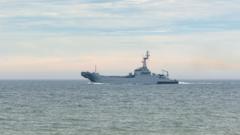NATO's launch of the Baltic Sentry mission comes in response to recent damages to crucial underwater infrastructure and reflects growing concerns over security in the region.
NATO Enhances Surveillance Mission in Baltic Sea Amid Undersea Infrastructure Threats

NATO Enhances Surveillance Mission in Baltic Sea Amid Undersea Infrastructure Threats
New Baltic Sentry initiative aims to secure critical undersea cables as tensions with Russia rise.
NATO has initiated a new mission aimed at enhancing surveillance and protection of critical undersea cables in the Baltic Sea, following multiple incidents of damage to this vital infrastructure. The initiative, named "Baltic Sentry," was announced by NATO chief Mark Rutte during a summit in Helsinki, which included representatives from NATO countries bordering the Baltic. This mission will deploy increased resources such as patrol aircraft, warships, and drones to monitor maritime activities closely.
While NATO has not directly implicated Russia in the recent cable damages, Rutte emphasized the need to bolster monitoring of ambiguous vessels linked to Moscow, commonly referred to as the "shadow fleet." The tensions between NATO nations and Russia have escalated significantly since the onset of the Ukraine conflict in February 2022.
The importance of undersea cables cannot be overstated; they not only facilitate electricity supply but also account for over 95% of global internet traffic. Rutte highlighted the critical nature of this infrastructure, stating that approximately 1.3 million kilometers of these cables underpin transactions worth around $10 trillion daily.
In recent months, unexplained damages to underwater infrastructure have surged, with the latest incident involving a cut electricity cable between Finland and Estonia. In a bid to secure their interests, the Finnish coast guard seized an oil tanker believed to be involved in the incident, while Estonia deployed patrol vessels to safeguard its underwater assets.
Estonia's Foreign Minister, Margus Tsahkna, has stated concerns over the increasing frequency of damage to submarine infrastructure, suggesting that these incidents are too frequent to be dismissed as mere accidents. Both he and Swedish Prime Minister Ulf Kristersson acknowledge the troubling pattern but refrain from making direct accusations without substantial evidence.
Experts continue to scrutinize the situation, as the potential for hostile actions in the region cannot be overlooked, given the uneasy maritime climate in the Baltic Sea.
While NATO has not directly implicated Russia in the recent cable damages, Rutte emphasized the need to bolster monitoring of ambiguous vessels linked to Moscow, commonly referred to as the "shadow fleet." The tensions between NATO nations and Russia have escalated significantly since the onset of the Ukraine conflict in February 2022.
The importance of undersea cables cannot be overstated; they not only facilitate electricity supply but also account for over 95% of global internet traffic. Rutte highlighted the critical nature of this infrastructure, stating that approximately 1.3 million kilometers of these cables underpin transactions worth around $10 trillion daily.
In recent months, unexplained damages to underwater infrastructure have surged, with the latest incident involving a cut electricity cable between Finland and Estonia. In a bid to secure their interests, the Finnish coast guard seized an oil tanker believed to be involved in the incident, while Estonia deployed patrol vessels to safeguard its underwater assets.
Estonia's Foreign Minister, Margus Tsahkna, has stated concerns over the increasing frequency of damage to submarine infrastructure, suggesting that these incidents are too frequent to be dismissed as mere accidents. Both he and Swedish Prime Minister Ulf Kristersson acknowledge the troubling pattern but refrain from making direct accusations without substantial evidence.
Experts continue to scrutinize the situation, as the potential for hostile actions in the region cannot be overlooked, given the uneasy maritime climate in the Baltic Sea.





















